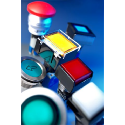Potentiometers
Informally known as 'pots', potentiometers are three-terminal resistors with a sliding or rotating contact which forms adjustable voltage dividers. If only two terminals are used, they act as variable resistors or rheostats. They consist of a resistive element, a sliding contact (wiper) that moves along the element and electrical terminals at each end. There is a mechanism that moves the wiper. There are a variety of potentiometers with different mechanisms which can slide or rotate. A linear slider potentiometer visually indicates the setting but a rotary potentiometer consists of a knob. They are also classified according to the material of the resistive element. Some of them are user-accessible whilst others are enclosed within equipment intended to be adjusted to calibrate the components during manufacture such as a digital potentiometer. Potentiometers are used to control electrical devices such as the volume controls on audio equipment and rotary types are built into position transducers such as joysticks for electronic games. Another domestic use is to control switching in light dimmers. Touch screen technology uses a two-dimensional membrane potentiometer. In DC motors, they are the simplest way of measuring angle or speed and are essential components in position sensors. Similarly, they control input for electronic circuits.
-
Tennco Distribution Ltd
View company profileAt Tennco Distribution Limited, we are a progressive electromechanical component distributor. We are family owned and operate in niche markets concentrating on electronic and electrical components for the computing, networking, instrumentation, panel building, audio and circuit board assembly industries.
Backed by 30 years experience, at Tennco, we are committed to service and efficient components distribution coupled with ISO 9002 approval. We offer products at competitive prices with a fast friendly and efficient service.
-
Paramount Electronics Ltd
View company profileAt Paramount Electronics we specialise in industrial electronic repairs, exchange circuit boards and the design and manufacture of industrial electronics. Our highly skilled engineers have the knowledge and experience to undertake almost any form of industrial electronic repair, and all repairs are completed at a fixed price with a 2 year guarantee.


